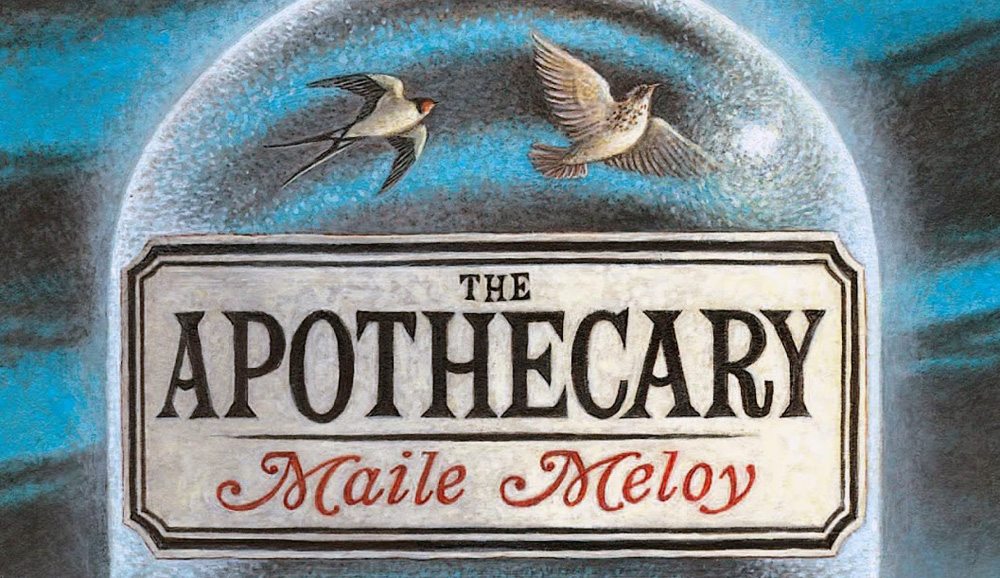I never know what to expect when I read a statement like “This is her first novel for young readers.” Is the author finally getting to fulfill a long-held desire to write a children’s book? Are they trying to cash in on what they see as an up-and-coming industry? Do they feel like writing for kids is somehow easier and they’re “taking a break” from writing for adults?
Maile Meloy’s reason for writing The Apothecary doesn’t easily fit into any of those categories. In her case, some screenwriter friends approached her with an idea, asking if she’d want to write a book. Meloy, between writing projects herself, decided to give it a shot, and got hooked on writing it — and if you read it, you’ll easily understand why.
The brief, spoiler-free plot summary is this: in 1953, a young girl moves to London with her blacklisted parents. There, she meets a curious apothecary and befriends a boy in her school who dreams of becoming a spy. Adventure ensues.
The book is told from Janie’s point of view, and we experience with her the strangeness of moving to another country, from sunny, carefree Hollywood to cold, war-scarred London. The whole world, still recovering from WWII, is now in constant fear of the Bomb — in particular, whether the Russians will get it, whether this new idea of a hydrogen bomb will come to fruition. The schools still have duck-and-cover drills, never mind that it wouldn’t save you from a conventional bomb, let alone an atomic bomb.
In the midst of all this, it seems completely natural that a 14-year-old boy would be obsessed with spying on people he finds suspicious. When he invites Janie to play chess with him at the park, it turns out that it’s not so much because he’s interested in her, but because he wants some cover for his espionage. This part reminds me a little of City of Spies: two nosy kids playing at spies, but then they happen upon something bigger, and get pulled into a whirl of events.
The Apothecary is beautifully written and really draws you into the world of post-war London. Despite its initial origin as almost something of a movie pitch, it’s not a traditional girl-meets-boy story. Yes, it’s about two teenagers who start with an uneasy friendship that becomes something more – but it’s not a typical teen romance, either, where you feel like the plot is just some big contrivance to get two people together in the end. In fact, it feels more real: Janie is immediately curious about Benjamin but doesn’t know what to make of her feelings, and is uncertain about his attention toward her. But most of the time they’re too busy dealing with their discoveries to really worry much about it anyway.
Note: some minor spoilers in the next paragraph!
Ideally, you’ll just go get a copy of this book now, and read it, because it’s really good. But if you insist on knowing more, here’s what I’ll tell you: the titular apothecary is no ordinary pharmacist. In fact, it turns out that he has been studying alchemy, and this introduces an element of magic to the story. Meloy does a great job with it, weaving the story of the alchemists with Russia’s attempts to build the bomb. Although it is magic, of a sort, the story deals with some of the more mundane aspects of it as well. For instance, the awkwardness of becoming invisible when it requires being naked — in the winter. How do you communicate with each other? How do keep from running into things? Where do you stash your clothes?
End of spoilers!
I started reading The Apothecary the day before Wordstock because it hadn’t arrived from the publisher until then, and actually stayed up past midnight to finish it before my interview with Meloy, because I really wanted to find out what happened. I gave it to my wife to read later, and she finished it in a day or two as well. I think the fact that Meloy hadn’t written for young adults before (in fact, hadn’t even really been aware of a “young adult” category) actually worked to her benefit, because she avoided a lot of the tropes and cliches that I often encounter in young adult books these days. I think it’s one that would certainly appeal to teens (and probably pre-teens) who like a bit of adventure, but it is also an excellent book for adults.
Oh, and one more thing: the cover and interior art, by Ian Schoenherr, is gorgeous and pitch-perfect. There’s one image at the beginning of each chapter (and just a few scattered illustrations elsewhere); each one hints at something that will come later in the chapter, but without being too explicit. It’s a delicate balance, drawing the reader forward without giving away too much, and Schoenherr does a superb job. One look and you’ll see why Meloy said one of the most rewarding things about writing a kids’ book was getting to have illustrations in it.
The book ends in such a way that this particular story is wrapped up, but it’s open for more. The universe that Meloy has put together in The Apothecary is one that, to paraphrase her, allows for possibilities.
Pick up a copy of The Apothecary, and read my interview with Meloy here.
Disclosure: Putnam Books provided a review copy of the book.


